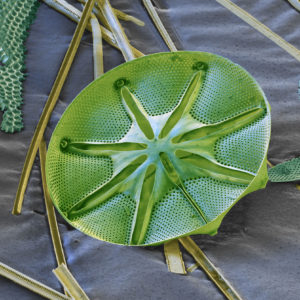For German caption please scroll down
Diatom, Asteromphalus sp. (probably A. humboldtii) from a south atlantic ocean deep sea probe. Diatoms are unicellular algae, the unique feature of diatom anatomy is that they are surrounded by a cell wall made of silica (hydrated silicon dioxide), called a frustule. Diatom morphology varies. Although the shape of the cell is typically circular, some cells may be triangular, square or elliptical. The cell itself consists of two halves, each containing an essentially flat plate, or valve and marginal connecting, or girdle band. One half, the hypotheca, is slightly smaller than the other half, the epitheca. Due to the rigid shell, the diatoms multiply through transverse division (hence the Greek name: diatomein = to split) Reproduction among these organisms is asexual by binary fission, during which the diatom divides into two parts, producing two “new” diatoms with identical genes. Each new organism receives one of the two frustules – one larger, the other smaller – possessed by the parent, which is now called the epitheca; and is used to construct a second, smaller frustule, the hypotheca. The diatom that received the larger frustule becomes the same size as its parent, but the diatom that received the smaller frustule remains smaller than its parent. This causes the average cell size of this diatom population to decrease. The smaller part is always reproduced until a critical minimum size is reached. Then a sexual phase of reproduction occurs, during which auxospores are formed. With sexual reproduction the original size is obtained again. I.e. Diatoms have a predominantly diploid life cycle. Diatoms occur in salt and fresh water, are the main constituent of marine phytoplankton, main primary producers of organic matter and generate a large part of the atmospheric oxygen. Geologically there are large deposits of diatom shells. These are called kieselguhr, diatomaceous earth, or diatomite. Diatomaceous earth can be used in


